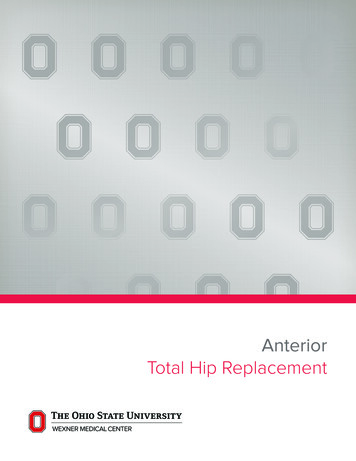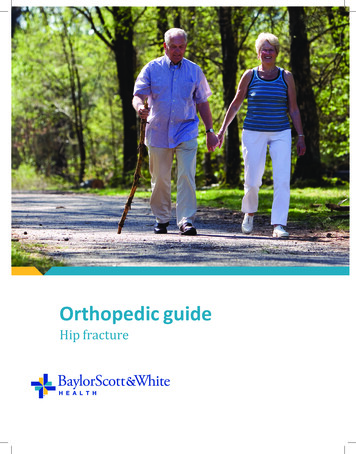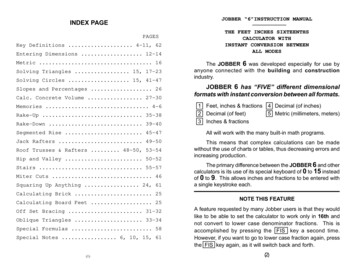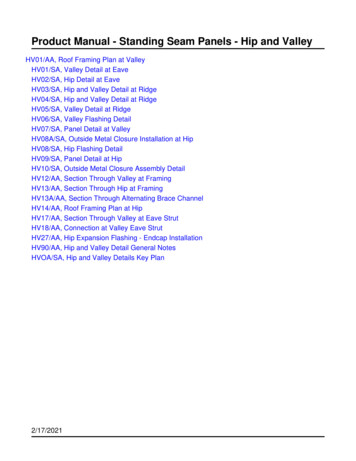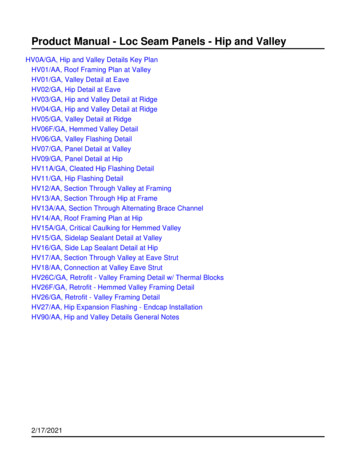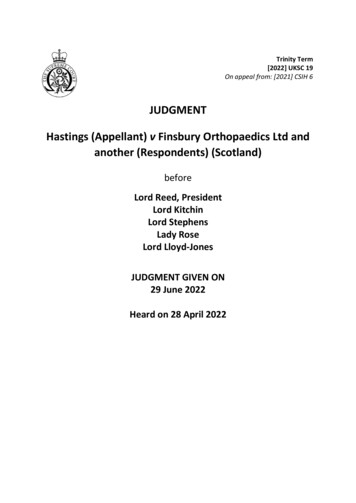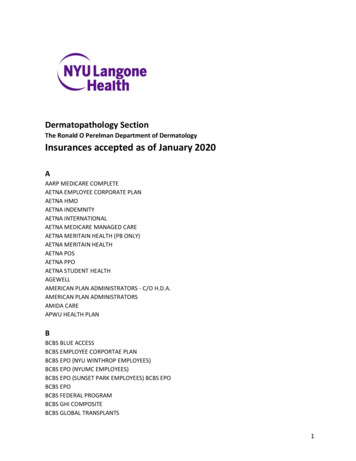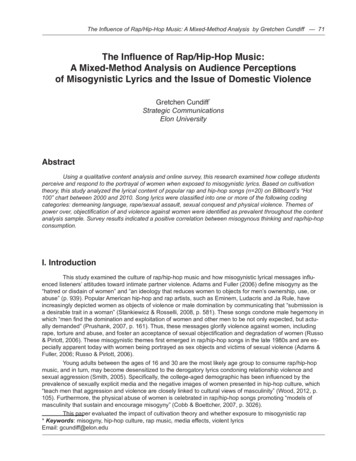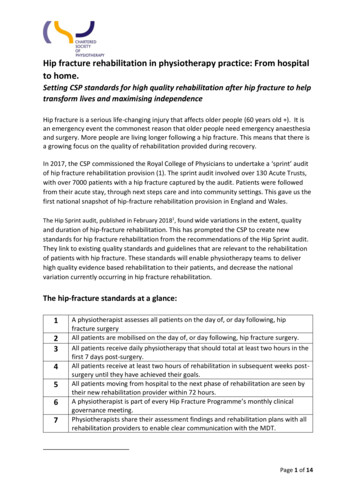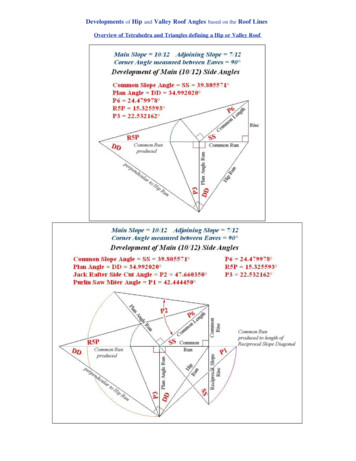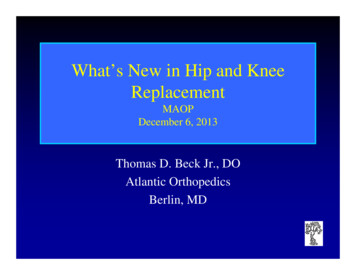
Transcription
What’s New in Hip and KneeReplacementMAOPDecember 6, 2013Thomas D. Beck Jr., DOAtlantic OrthopedicsBerlin, MD
Disclosure
Objectives Keep the audience awake Review availableArthroplasty proceduresfor hip and knee arthritis Discuss New proceduresand practices Provide generalunderstanding of JointReplacement Surgery forthe PCP
Overview Most of what is new doesnot occur in OR Change in Health CareSystem focusing on costreductions, outcomes andprevention ofcomplications Some New toys !!
AAOS Evidence Based Guidelines, 2nd EditionNon-Arthroplasty Treatment of Knee Arthritis List of evidence-basedtreatment recommendations Full Guideline– 1196 pages– 20 member workgroup– Over 10,000 separatepieces of literaturereviewed– 16 peer reviewerrepresenting multiplespecialty societies
Goals and Rationale Improve treatment based on current best evidence Systematic review of available literature regardingtreatment of Knee OA Demonstrates:– Good evidence– Where evidence is lacking– Topics that future research must target
Intended Users Orthopedic Surgeons All qualified Physiciansmanaging patients withKnee OA Insurance carriers Governmental bodies Health-Policy decisionmakers
Knee OA Guidelines Strong Recommendation– Quality of supporting evidence is highModerate Recommendation– Benefits exceed the potential harm Or opposite in case of negative recommendation– Quality of supporting evidence not as strongConsensus Recommendation– Expert opinion supports the guideline recommendation eventhough there is no evidence that meets inclusion criteria ofliterature reviewInconclusive Recommendation– Lack of compelling evidence, benefits vs harm unclear
Article Inclusion Evaluated a treatment for KneeOAEnrolled a patient population ofat least 80% patients had KneeOAReported quantified resultsFull article published in Peerreviewed JournalWas not Cadaveric, animal or invitro study Enrolled 30 patients in eachstudy armFollow up at least 4 weeks 80% patients were 19 years orolderEnglish language articlePublished after 1980Not retrospective chart reviewWas prospectiveMeasured patient orientedoutcomes
Recommendation 1 Patients with symptomaticOA of knee participate inself managementprograms, strengthening,low-impact aerobicexercise andneuromuscular education– Strong
Recommendation 2 (my #1)Patients with BMI 25should be encouraged to loseweight Minimum 5% of bodyweight– Maintain weight at lowerlevel with appropriate dietand exercise– Moderate
Obesity Patients with BMI 40 show 70 % increase insurgical complications– Wound healing problems– Infection– Failure of components– Poor functional outcome– Nonsurgical morbidity
Obesity
Obesity
Recommendation 3 (a,b,c) 3a– Cannot recommend use ofacupuncture (Strong) 3b– Unable to recommendphysical agents includingelectrotherapeuticmodalities (Inconclusive) 3c– Cannot recommend for oragainst manual therapy(Inconclusive)
Recommendation 4 Unable to recommendfor or against valgusdirecting force brace– Inconclusive
Recommendation 5 Cannot suggest lateralwedge insoles– Moderate
Recommendation 6 Cannot recommendGlucosamine and/orChondroitin sulfate Strong
Recommendation 77a7b Recommend NSAIDS orTramadol– Strong Unable to recommend for oragainst use ofacetaminophen, opioids orpain patches– Inconclusive
Recommendation 8 Unable to recommendfor or against the useof intra-articularcorticosteroids– Inconclusive
Recommendation 9 Cannot recommendintra-articularhyaluronic acidinjections for patientswith symptomatic kneeOA– Strong
Recommendation 10 Unable to recommendfor or against growthfactor injectionsand/or Platelet richplasma– Inconclusive
Recommendation 11 Cannot suggest the useof needle lavage– Moderate
Recommendation 12 Cannot recommendarthroscopy withlavage and/ordebridement– Strong
Recommendation 13 Unable to recommendfor or againstarthroscopic partialmenisectomy– Inconclusive
Recommendation 14 A valgus producingtibial osteotomy maybe performed inpatients withsymptomatic medialOA– Limited
Recommendation 15 It is opinion of workgroup not to use freefloating interpositionaldevice– Consensus
CMS THA/TKA account for the largest procedural costto the CMS budget each year– Prime focus for identification of qualitymeasures 2 hospital level quality measures– Complication rate– 30 day all cause readmission rate
CMS Complications (4.23%)– Acute MI, pneumonia, sepsis, surgical bleedingrequiring reoperation, pulmonary embolism,death in 30 days, mechanical complications,joint infection, wound infection within 90 days
CMS Criteria for Total JointReplacement Must have failed all of the following treatmentoptions– NSAIDs, joint injection, use of assistedambulatory device/brace, physical therapy Must have documentation of– Swelling– Pain preventing activities of daily living– Radiographic findings of osteoarthritis
CMS Mandates on patientoutcome measureshave driven thefollowing initiatives– Pain management– Acceleratedrehabilitationprotocols– Blood managementstrategies
What’s New, What’s Not Perceived as New– Minimally invasive surgery– Unicompartmental KneeReplacement– Alternative Bearings– Trabecular Metal– Bone Grafting Techniquesfor Revision Surgery– Computer Assisted Surgery– Hip resurfacing– Get Around Knee– Patient Matched Blocks Sort of New– Alternate Bearings– Trabecular Metal– /- Hip Resurfacing– Direct Anterior Aproach– Patient Matched Blocks– Multimodal Pain Protocols– Accelerated Rehab– Blood Management
Direct to Consumer Marketing Much like Pharmacuetical Companies, Orthopedic ImplantCompanies have begun direct to consumer marketing. Companies make claims withoutgood clinical data Patients percieve something recently advertised as new andimproved– This is often not the case Patients are demanding “new” technology Many Physicians are taking advantage of this to increasemarket share
An Evaluation of Information Available on the InternetRegarding Minimally Invasive Hip ArthroplastyLabovich et al, JOA 1/06 Evaluated 150 Web sites (3 search engines)– Hospital/University – 45%– News Stories – 26%– Private Medical Groups – 25%– Orthopedic Industry Sites – 6% 9% of sites referenced peer-reviewed publications 41% described the surgical technique
An Evaluation of Information Available on the InternetRegarding Minimally Invasive Hip ArthroplastyLabovich et al, JOA 1/06 15% explained eligibility 45 sites offered the opportunity to make anappointment 13% explained the risks of the procedure More than 91% of the sites made specific claimsregarding the advantages of MIS surgery Conclusion: “the information on the Internetregarding minimally invasive total hipreplacement is misleading and of poor quality.”
Minimally Invasive Surgery Companies and Surgeons began to advertise priorto any randomized controlled studies Patient saw it advertised and demanded it. All benefits were perceived Now randomized prospective studies publishedshowing no benefit
Minimally Invasive Surgery The hope was that less damage to the soft tissueswould provide– Decreased blood loss– Less pain– Faster recovery Original series however combined the change insurgical procedure with a change in pre and postop pain protocols
Total Hip ArthroplastyIs Small Incision Better?Rothman et al, JOA 6/06 Matched pairs comparing regular to small incision THA No difference in: blood loss, analgesia requirement,functional recovery, LOS or disposition at discharge. One patient in small incision group required revision at 8months “ unable to detect any difference in outcome parameters” “ recent extensive interest for MIS THA has been atributedto market-driven and patient driven demand for theprocedure”
What’s New
Pain management Goals– Reduced narcotic use– Facilitate early rehabilitation– Facilitate early hospital discharge– Enhance patient’s satisfaction– Accelerated return to function
Pain management Multimodal protocols– NSAIDs (Celebrex/Mobic)– Long-acting oral narcotic (OxyContin)– Lyrica– Peripheral nerve blocks– Intra-articular injections with “cocktails” Bupivacaine, Depo-Medrol, morphine,Toradol
Accelerated rehabilitation Patient’s begin rehabilitation protocolspreoperatively Out of bed on postop day 0 Surgical approaches– Direct anterior approach to the hip– Quadriceps sparing approach to the knee
Direct Anterior Approach Hip Patient supine duringprocedure– Better evaluation ofthe leg lengths– Preferred byanesthesia Single anterior incision Only tensor fascia latamuscle split– Posterior approach
Direct Anterior Approach Hip Matta Table– Expensive– Ankle fracture– Unable to stabilitytest Keggi Approach– standard OR tableused
Blood management Tranexamic acid– Antifibrinolytic– Inexpensive ( 5)– IV or intra-articular– TKA Decreased transfusion from 13.1% to 2%– THA Decreased transfusion from 13.5% to 3.6%– Savings 65,000 per 1000 TJR
Blood Management Aquamantis– Bipolar sealer which deliversher frequency energy and salinesimultaneously– process heats tissues to around100 degrees centigrade, muchless than for standardelectrocautery, shrinking thecollagen in the walls of thetissue vessels– Expensive 500 per case
Arthroplasty for Treatment ofKnee OA Standard TKA– Cruciate substituting– Cruciate retaining– Bicruciate substituting– Rotating platform Unicompartmental– Femoro-tibial– Patello-femoral
Unicompartmental KneeReplacement One Compartment involved– Medial– Lateral– Patella-femoralLess invasive surgerybone preservingMore natural feelQuicker recoveryLast approximately 10 yearsRevision surgery easier
Patello-Femoral Replacement Resurfaces patellofemoral joint Versions have been usedover past 20 years Poor instrumentation Newer designs andinstruments now available Easier revision
Total Knee Replacement Highly successful– Provide excellent pain relief– Restores joint function (not bionic) Survivorship– 10 years-98%, 15 years-92%, 20 years- 85% Complications– Infrequent but devastating– PE, MI, infection
Standard TKA Replaces all 3 compartmentsHighly successful procedurePain reliefIncrease functionLongevity ?
Rotating Platform Knee Perceived as new Actually has been in usesince 1977 Theory is that ROM willincrease and will generateless wear debris No studies have shownany difference betweenthis and a fixed bearingknee
Get Around Knee Marketed as newdesign Actually was releasedprior to 1996 bydifferent companyunder another name No studies showingany advantage
Journey TKA Substitutes for ACL andPCL– Other systems eitherretain PCL orsubstitute for it, noneaddress ACL Made of Oxinium Designed for high demandpatient 30 year knee
Oxinium Is a metal that is treatedwith heat and oxygen Transforms the outer layerinto a ceramic Decreased wear debris Scratch resistant Can not break Available in Knee and HipComponents Lubricious
Lubricious Having a slippery orsmooth quality Joint fluid forms film onOxinium, reducing weardebris even more
TKA
CAS Computer assisted surgery Available for THA andTKA Average alignment doesnot change Reduces outliers May be beneficial inObese patients withdifficult landmarks
CAS Adds time to procedure Must drill pins into boneat distant sites Equipment is costly Not reimbursable Will probably not changerevision rate
CAS
Patient Matched Cutting Blocks X-ray, MRI/CT Computer generatedcutting blocksmanufactured Enhanced alignment Dereased surgical time Decreased exposure Canals not violated Increased Cost
Total Hip Replacement First performed in 1960 Ball and socket of hip joint resurfaced with metal andplastic (traditionally)– Ceramic-plastic– Ceramic-ceramic– Metal-metal– Oxinium-plastic Fixation– cemented– Hybrid– Cementless Has evolved into the preferred surgical techniqueover the past 3 decades
Alternate Bearings in THA Ceramic-Ceramic– Excellent wear properties– Reduces 3rd body wear– Limited sizes Neck lengths– Potential for ceramic fracture Rare Decreased with newer generation of ceramics
Alternate Bearings in THA XLPE– Cross linkedPolyethelene Radiation– Current industrystandard– Articulates with metalor ceramic Engh et al––––Min 10 year F/U114 conventional PE116 XLPERevisions 8 CPE 0 XLPE– Linear wear CPE 0.21 mm/yr XLPE 0.03 mm/yr
Hip Bearings
THAOxinium
Metal – Metal THA Seemed to be attractivealternative– Large heads (stability)– Low wear debris 2x greater failure rate Failure Causes– Corosion– ALTR (pseudotumors)– Systemic Metal ions
Hip Resurfacing Ideal candidate is active male 60 with OA Represents 4% of hip replacement surgeries(2009) 1.4 to 3.6 higher revision rate than standard THA– Femoral neck fracture– Surgical experience decreases revision rate– Not all resurfacings created equal
Resurfacing Consensus Group Surgeon should not do resurfacing untilcompleting 200 conventional total hiparthroplasties Best candidate is male patient with OA Female should not be excluded women of childbearing years should be excluded Patients with metal allergies should be excluded Patients with abnormal anatomy should beexcluded
Birmingham Hip Resurfacing Swedish registry showsinferior results in males 60 with conventional THAcompared to generalpopulation Higher demand Current data shows littledetectable clinicaloutcome differencesbetween resurfacing andtotal hip
Birmingham Hip Resurfacing Women can still becandidate Must assure noosteoporosis or osteopenia– Bone Density test
Birmingham Hip Resurfacing Decrease chance ofdislocation– Large head size No activity restrictions May run– Prohibited withconventional THA
Birmingham Hip Resurfacing Metalurgy is the key Metal on metalarticulation Cobalt – chrome with ahigh carbide content– Increases the wearresistance
Birmingham Hip Resurfacing The procedure is bonesparing The femoral canal is notviolated This conserves bone andmakes a later revisionsurgery easier This makes it ideal foryounger high demandpatients
Birmingham Hip Resurfacing
Revision SurgeryBone Grafting Techniques
Revision SurgeryBone Grafting Techniques
Revision SurgeryBone Grafting Techniques
Revision SurgeryBone Grafting Techniques
Trabecular Metal Porus tantalum metalHighly biocompatibleLow stiffnessHigh frictionStructural stabilityHigh strength to weight ratioOsteoconductiveTissue ingrowth occurs
Trabecular Metal
Trabecular Metal
Trabecular Metal
Trabecular Metal
Questions
AAOS Clinical Practice GuidelinesVenous Thrombo-embolism Work Group evaluatedavailable EnglishLiterature concerning– Patient Screening– Risk FactorAssessment– Prophylactic Treatment
AAOS Clinical Practice GuidelinesVenous Thrombo-embolism Purpose– Help improve treatment based on current bestevidence– Provide practice recommendations– Highlight gaps in Literature Require further research
AAOS Clinical Practice GuidelinesVenous Thrombo-embolism Review English Literature after 1970 10 Recommendations– 1 Graded Strong– 4 Consensus– 1 Weak– 3 Moderate– 1 Inconclusive
AAOS Clinical Practice GuidelinesVenous Thrombo-embolism Recommendation 1 (Strong)– Recommend against routine Duplex USscreening Recommendation 2 (weak)– Current evidence is not clear whether otherfactors increase the risk of VTE in THK/TKApatients– Previous VTE is the only risk factor that mayplace patient at a higher risk
AAOS Clinical Practice GuidelinesVenous Thrombo-embolism Recommendation 3 (consensus)– Patients are at risk for bleeding complications– Patients should be assessed for known bleedingdisorders ( hemophilia/liver disease)
AAOS Clinical Practice GuidelinesVenous Thrombo-embolism Recommendation 4 (moderate)– Antiplatelet agents should be discontinuedbefore surgery (aspirin/Plavix)
AAOS Clinical Practice GuidelinesVenous Thrombo-embolism Recommendation 5 (moderate)– Pharmacological agents and/or mechanicalcompression devices should be used in patientswho are not at elevated risk for VTE– Unable to recommend for or against specificchemotherapy prophylactic agents Current evidence unclear about whichprophylactic strategy is optimal/suboptimal
AAOS Clinical Practice GuidelinesVenous Thrombo-embolism Recommendation 6 (consensus)– Patients with bleeding disorders should usemechanical compression devices only Recommendation 7 (consensus)– Patients with previous VTE should receivepharmacologic and mechanical prophylaxis
AAOS Clinical Practice GuidelinesVenous Thrombo-embolism Recommendations 8 (consensus)– Early mobilization is encouraged Recommendation #9 (moderate)– Neuraxial anesthesia suggested Limits blood loss Evidence suggests that it does not affectVTE
AAOS Clinical Practice GuidelinesVenous Thrombo-embolism Recommendations 10 (inconclusive)– Current evidence does not provide clearguidelines about whether IVC filter preventsPE in patients with contraindications tochemoprophylaxis– Unable to recommend for or against
Thank You
Total Hip Replacement First performed in 1960 Ball and socket of hip joint resurfaced with metal and plastic (traditionally) - Ceramic-plastic - Ceramic-ceramic - Metal-metal - Oxinium-plastic Fixation - cemented - Hybrid - Cementless Has evolved into the preferred surgical technique over the past 3 decades
